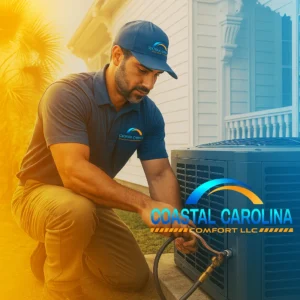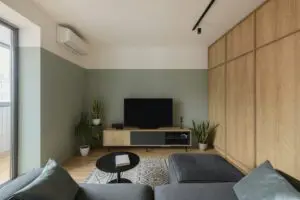When most people think about home comfort, they picture things like a well-running AC, a reliable heater, or a ceiling fan spinning overhead. But one of the biggest pieces of the comfort puzzle is often invisible: the air you’re breathing inside. Indoor air quality can have a huge effect on how you feel day to day. It can impact everything from your energy levels to your allergies. That’s why spotting common indoor air problems and knowing how to handle them matters, especially in humid places like Charleston.
Air in your home can carry more than just a breeze. Dust, pet dander, mold spores, and even pollen can drift through your HVAC system and settle in different corners. Without the right circulation and filtration, your home’s air can start to feel stale or stuffy. Worse, it can make allergy symptoms spike and create long-term issues for people with asthma or other breathing concerns. The good news is these problems can be fixed once you understand what you’re up against.
Understanding Indoor Air Quality Problems
Indoor air quality, or IAQ, is all about the health of the air inside your home. It’s something you can’t always see or smell, but you’ll definitely feel it when it’s off. Poor IAQ can lead to headaches, constant sneezing, or even fatigue. Many of these problems come from common air pollutants that are floating around inside without you realizing it.
In Charleston, moisture is a big factor that makes homes more prone to indoor air issues. Mold and mildew love a damp environment, and when the humidity isn’t balanced, these visitors can show up inside your vents, walls, or around windows and doors. Pollen is another problem during warmer months, sneaking in through open windows or hitching a ride on your clothes or pets.
Here are some common indoor pollutants that could be in your home:
– Pet dander that sticks to surfaces like rugs and furniture
– Dust mites hiding in bedding and upholstery
– Pollen brought in from outside during spring and summer
– Mold spores feeding off humidity and spreading via your HVAC system
– Everyday chemicals from cleaning supplies or air fresheners
Knowing what’s in your air is the first step. Once you’ve got a handle on the usual suspects, it gets easier to clean up the air and keep it that way year-round.
Identifying Common Indoor Air Issues
Sometimes the air just feels off. Maybe your house smells musty, or certain rooms feel hotter or stuffier than others. Bad indoor air habits and hidden HVAC issues are common causes. One of the biggest culprits is poor ventilation. Without enough fresh air running through your home, pollutants start to build up and airflow gets blocked, especially in rooms with fewer windows or older ductwork.
Humidity also plays a bigger role than people think. Too much of it, and your home becomes a breeding ground for bacteria and mold. Too little, and your skin dries out and your throat starts to feel scratchy. Air that’s out of balance invites all kinds of issues.
Then there’s your ductwork. Over the years, ducts collect dust, debris, and even pests. Cracks or loose seals let dirty air flow back into your living spaces. You may notice more dust collecting on surfaces, or your HVAC system could start to work harder without keeping the house comfortable.
Here are a few signs your air might not be as clean as it should be:
– Rooms that smell musty or feel damp
– Dust building up quickly even after cleaning
– Hot and cold spots in different parts of the house
– More frequent allergy or breathing symptoms indoors
– HVAC filters filling up faster than usual
If you’ve checked off a few of these, it might be time to take a closer look at your air system and your home’s airflow. Fixing the root of the problem often starts with inspecting the hidden parts of your HVAC setup.
Effective Solutions for Better Indoor Air Quality
You don’t have to put up with poor air quality inside your home. There are several effective ways to tackle these problems and breathe easier. Start with regular repair and maintenance of your air ducts. If your ducts have seen better days, dust and allergens can find a way in, reducing your air quality. Scheduling a thorough inspection can catch these issues early and keep your HVAC system working efficiently, ensuring that clean air flows freely throughout your home.
Adding air purifiers or installing high-quality HVAC filters is another practical step. These tools trap unwanted particles before they circulate in your rooms, filtering out dust, pollen, and other allergens. If you’ve noticed more sneezing or coughing than usual, these solutions can help clear the air and reduce those pesky symptoms. Plus, modern filters and purifiers are easy to maintain and replace, making them a long-term partner in your effort to improve air quality.
Managing moisture and allergens is also key. Keep humidity levels balanced by using a dehumidifier, particularly in damp areas like basements or bathrooms. This helps prevent mold growth and keeps the space feeling fresh. Regular cleaning of surfaces where dust and pet dander collect, like carpets and curtains, also helps reduce the buildup of allergens.
The Importance of Professional Help
While it’s tempting to solve air quality issues on your own, sometimes the problem needs expert care. DIY solutions often overlook hidden causes, like internal ductwork problems or hard-to-reach mold. Professionals have the experience and tools to thoroughly assess and address these complex situations.
Having a trained eye can make a big difference, especially when dealing with persistent issues. Professionals can carry out a comprehensive indoor air quality assessment to identify sources of pollution and recommend the best mitigation strategies. They’re also skilled in optimizing your ventilation system, ensuring it effectively pushes out the bad air while bringing in the fresh.
If your ductwork has cracks or buildup that’s hidden from view, hiring a trusted team like Coastal Carolina Comfort can mean the difference between short-term relief and long-lasting clean air. With local experience in Charleston’s climate and indoor challenges, professional attention can help restore the air flow and quality your home needs.
Simple Ways to Keep Charleston’s Indoor Air Fresh
Maintaining good air quality is an ongoing task that rewards you with a fresh and healthy home all year. Simple routine practices can significantly impact how your Charleston home feels. Change HVAC filters regularly, ideally every three months, to keep the system running smoothly and avoid clogging with dust. Regular inspections of vents and ducts prevent dirt and allergens from building up over time.
Here are some tips to maintain air freshness:
– Keep the humidity in check with dehumidifiers in damp areas
– Clean and dust surfaces frequently, including under and behind furniture
– Place doormats at entrances to reduce dirt and pollen brought in from outside
– Avoid heavy use of scented sprays or products that add chemicals to the air
Seasonal transitions also provide the perfect opportunity to check in on your HVAC system. Whether it’s preparing for summer heat or cooler weather, tuning up your system and checking airflow helps keep indoor conditions balanced.
Whatever the weather, keeping an eye on indoor air quality helps ensure your home offers a comfortable retreat from the outside world. Making these changes can drastically improve the air you breathe every day, creating a safer and more pleasant living space.
Keeping a clean air environment in your Charleston home doesn’t have to be a struggle. If you’re ready to improve your indoor space, consider making regular air duct repair part of your routine to help keep dust and allergens at bay. At Coastal Carolina Comfort, we understand the unique challenges of Charleston’s climate and are here to help make your home a healthier place to live.


